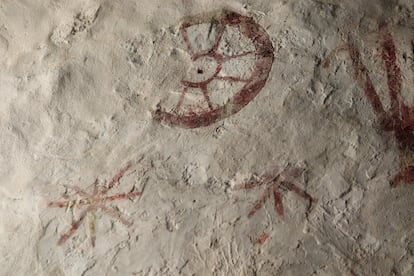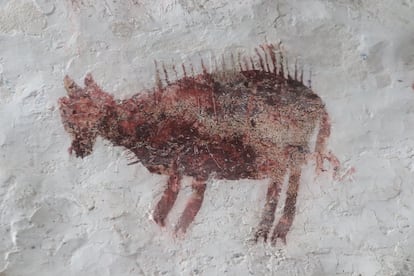In one of the walls of the Church of Arbulo, a Alavés town of just a hundred inhabitants, several schematic figures (crossings, eight -radius wheels) appear along with naive animals, such as wild boars, various birds faced or a real turkey. They do not follow any logical order, they are “like floating” on the wall, they are of a slightly off red color, and their seniority dates back to the twelfth century. The art historian Gorka López de Munain, a native of the area, knows the usual temple. But it is now, when, after a recent restoration, these drawings have been discovered in the oldest wall of the building, it turns it (and more turns) to its possible meaning in a conscientious investigation.
Until now, the professor at the University of the Basque Country has found some answers – as the fact that it is not an isolated example, but a “cultural phenomenon” present in other medieval temples – but there are still many questions. What are the meaning of these drawings in an allegedly Christian church? Did they do behind the dominant religion? And, above all, what do they want to tell us?
Until now, of this type of paintings – pequematic and red – there was hardly any information. “We had not studied them because they were outside the historical-artistic fee,” explains the historian. That is, regardless of art that we usually associate with the catalog of the twelfth and thirteenth centuries, of those frontal images and varied colors so characteristic of the Romanesque, to the most expressive of the Gothic. Always with Christian religion as a dominant theme.
However, these others “are very interesting to understand the society of the moment,” says López de Munain. Because these types of drawings are not exclusive to the church of San Martín de Arbulo. They can also be seen in more buildings in the province of Álava – the mysterious decoration of the Alaiza Church is currently the most popular – and there are other similar samples outside the Basque Country. Investigations such as this teacher and recent restorations have resulted in new findings, and thus arises clues about an unresolved enigma.
Anyone who observes the drawings of Arbulo will have the feeling that he has seen them before elsewhere. In fact, they are within a visual culture that “connects with a long -distance repertoire that comes from antiquity and remains alive in the Middle Ages.” Like solar discs, which “are present in ancient cultures, even pre -Roman, and then move to the Roman world through steles and tombstones,” Revela López de Munain, who studies this type of artistic expressions in a temporary fork as wide as possible. The reasons are the same, but their meaning is different. Because the only thing that has been maintained is the appearance, the shape of the drawings. “Probably, the meanings have been modified until they even change completely radically; today many of these images have been resignified, for example, within the Basque Culture and Imaginary, where they mix with an already look at the 21st century,” says the historian.
But, beyond its artistic invoice, its naivety, its simplicity and color, why do I illustrations and those of San Martín de Arbulo call? “When you enter a church of the twelfth century, what one expects is a Christian iconography, as in other places,” says the professor of the University of the Basque Country. “And that is the fundamental thing, that it is not about that type of iconography, which makes it more difficult to understand them.”
What most caught attention to Gorka López de Munain were animals that look like a wild boar or pork. “The figure of a real turkey can be connected with other traditional models, but a wild boar in the middle of nowhere and some quadrupeds with claws seems to be representing the environment, instead of a known current or repertoire,” he analyzes. As for the eight -spoke records that appear on the medieval wall of the church – one of them, larger and two concentric spheres, as if it were the wheel of a cart – points out that he realized “that they were present in other objects to which we have not paid much, such as the steles”. Very frequent elements also in another of the great artistic contributions of the Romans, the mosaics.

With all these data on the table, it was time to launch a hypothesis, an explanation of the set. “These are Churches of poor constructive ambition, promoted by the little nobility of the place, and this was his imaginary,” says López de Munain. That is, temples like Arbulo were “private churches”, whose owners projected what they saw in their surroundings. But why elements of Roman culture, for example? “They were aware that there were other antiquity buildings (La Romana, in this case) that were associated with something prestigious,” proposes the historian. If they used symbols of an older culture and with a high reputation, their lineage would somehow date back to that time of splendor. And they also did it as an expression of “a popular look,” warns the researcher, about a detail that tells us about “social classes of which, until now, we know very little.”
The detailed investigation has allowed López de Munain to approach the true meaning of the Arbulo program, which is summarized in a simple idea: “Find a prestige image and appropriate it.” But one could still take another step. The track was in some of the animals represented. “Some of the images have a clear funeral tradition, such as royal turkeys or birds faced with a cluster of grapes that appear in Roman tombstones,” he describes. Therefore, “this type of churches were used to bury themselves, as seen through archeology,” reveals the teacher. “They were private temples where the owners did a little what they wanted, regardless of the interference of the episcopados,” he adds.
The reasoning allows you to launch a last question: do these types of images answer particular beliefs, behind the dominant religion, of Christianity? “It is a very difficult question to answer; of course, behind the bishopric, yes,” says López de Munain.

Because, perhaps, what these drawings want to tell us is that temples like Arbulo were not exactly Christians. “The crosses we see are the only thing that tells us that we are in a Christian church because, from the rest, nor one of the images refers to it,” replies the researcher. And the same goes for the rest of medieval buildings that look like those red, schematic paintings, so characteristic of the province of Álava. But, then, if they were not Christian, what were they? The objective of the investigation is not to offer all the answers (impossible mission), but “take a first step” and open the way to other investigations to better learn an art that, for getting out of the marked path, has been relegated to oblivion.

